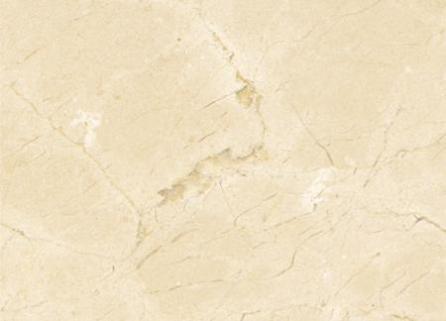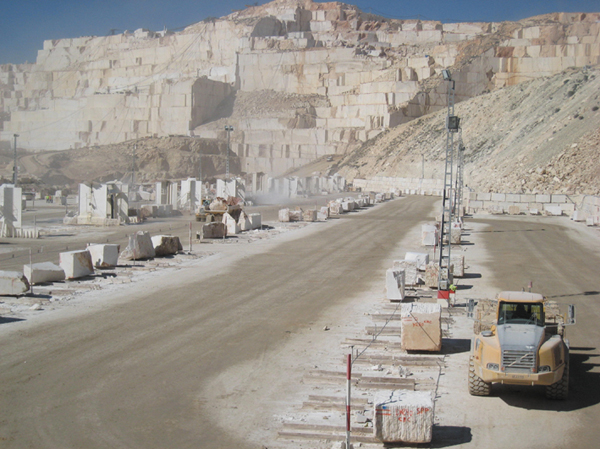Of the hundreds, indeed, thousands, of different varieties of natural stone that are being extracted, processed and commercialised in the world, there are actually very few materials that have carved out their own brand name and are easily recognisable and whose name is familiar even to those who do not strictly work in the natural stone industry. That material is called Marmol Crema Marfil®.
Marmol Crema Marfil® is a beige coloured marble extracted principally in the mountain called El Coto in Pinoso (Alicante, Spain). Stone extracted in the nearby areas is also in the commercial sense sold under the same name, the original being from the El Coto mountain. There are approximately 20 quarries where extraction of the material is taking place. The amount extracted varies from year to year, on average, approximately 500.000 cubic metres are annualy extracted. An important local processing industry has developed around this material, with many factories located in the nearby towns of Novelda, Monforte del Cid, La Romana, Monovar, Pinoso, Elda and Algueña The total number of people directly employed in the stone industry developed mainly as a result of the extraction and processing of Crema Marfil( but also including a large variety of other stones both extracted within Spain and imported), is estimated to be 5000.
Such is the popularity of Crema Marfil that it is exported today to more than 100 countries all over the world. Many major projects have been done with this material and its use is also extremely popular in small size decoration projects and in the houses in small quantities. Its unique beige colour allows one to combine it with almost any other different stone colour or shade or any type of decoration, this being one of the reasons for its great popularity.
Classifications of Crema Marfil
Being a natural material, common sense suggests one should not expect complete uniformity. The industry has, therefore, developed a wide range of classifications based mostly only on aesthetic criteria, but it can be sometimes maddening even for the experienced industry professionals to identify and obtain a particular variety of Crema Marfil. The difficulty becomes even greater when one considers that different companies often give different names for the different varieties.
The first, often surprising, revelation comes when one starts examining the Crema Marfil phenomenon–one immediately becomes aware that it is a world in itself. In fact, it would be more accurate to describe Crema Marfil as a family of similarly looking materials, the common element being it is beige in colour and the place from where it is extracted. Just examine the different classifications, for example, which reflect the different variations in which this material can be found, for there is no homogenous colour.
One commonly used criteria for separating Crema Marfil in different classifications begins with the division into dark tone or a light tone, for it can be found in both the tones.
Next comes another criteria into play, the type of veins in which the material comes. Is the material free of veins, as it sometimes is, or does it have veins? Is there a small concentration of veins, or is there a high concentration of veins ? Of course, not forgetting that both the small and high concentration of veins could come both in the dark tone variety, and also in the light tone variety.
But, Nature being Nature, its ways of teasing human beings does not stop there. It forces the industry people to consider in its classification process, a variety of Crema Marfil that comes with different types of grains, these grains look like rice, and, of course, these grains come both in the light version, or in the dark version of the material. (This “rice grain” variety, as the industry folk call it, is actually a fossil). The variety of “rice grain” can also come with veins, both in the light and the dark version.

.jpg)
So now, one would think, the job of different classifications is surely over and done with ? Wait a minute, Nature says, for I have not finished with you mortals yet. There is even more choice, it says. And thus Crema Marfil is also found in a variety which the Spaniards, after much reflecting, have decided, it is best to call the “water variety”. Why ? When the surface is polished, the stone look in this variety seems to look like ocean waves. This happens because the fossils become aligned in a way that forms a wavy pattern. .
Then there is yet another variety that also comes out- a type of Crema Marfil with a pinkish tone. And another one, with a greenish tone. But these varieties, till now, are found in small quantities.
Another variety of Crema Marfil is called by the local people as the “flower” type. This is one which has white spots, which look like flowers, and these white spots have the size of a coin. Sometimes the white spots are well distributed and sometimes the spots not so uniformally distributed.
Finished ? Not yet. There is a also a variety of Crema Marfil which comes in the variety “encalizado”, i.e., the veins are that of white limestone.
What finishes are the most popular, or the more recommendable for Crema Marfil?
Crema Marfil in the polished finish is, without doubt, the one most people are familiar with. But the aged finish is also done by the processing factories as is also the honed, sanded, bush hammered finishes. In the case of projects, the material in the honed finish is usually sent to the destination where the surface is often polished once installed. Another finish, done on a smaller scale, but visually attractive, is the “escarfilado” one, which often comes in sizes 20 x 10 or 25 x10 cm in different sizes.
How is Crema Marfil different from other similar looking limestones?
In some cases, stone installers have used marble limestones from other places and sold it under the name of Crema Marfil, exploiting the ignorance of the final buyer not familiar with natural stone. The local people as well as most repeat buyers in other countries, however, are very clear on this point. They insist there are few materials that have the characteristics of Crema Marfil, and those who know Crema Marfil well, would never confuse it with other materials. Other materials may be more crystaline, or more limestone, even looking similar. But in its touch, in its colour, in its polish, and in consistency defined in terms of strength, Crema Marfil is unique, they insist.
Technical Characteristics of Crema Marfil
Volume Mass 2.68 gms/cm3
Absorption coefficient 0.07%
Porosity 1.30%
Compression strength 1.557 kg/cm3
Bending strength 148 kg/cm3
Frictional wear test 0.35 mm
Impact test 23cm
Microstrength on impact 157 kg/mm2
Weight loss after freezing 0.00%
Compression strength after freezing 1.352 kg/cm3
Conclusion
In terms of volume extracted and processed, Crema Marfil is one of the biggest materials in the world of the natural stone industry. The huge reserves of this material, because of the size of the mountain, means there is still a lot of material left, and the industry has no fears that the reserved of this material will be finished any time soon. There are decades of life still left for the industry built around Crema Marfil. What the mysteries of nature hold for the material that will be extracted in the future, in terms of tones, veins, and other aesthetic aspects, obviously no one knows. But of one thing one can be sure, as natural stone keeps becoming more and more popular all over the world, Crema Marfil, too, will continue to find great international demand.

Note: Marmol Crema Marfil is the name registered by the Association Marble of Alicante. info@marmoldealicante.com
